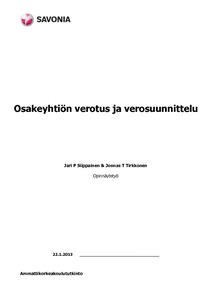| dc.contributor.author | Tirkkonen, Joonas | |
| dc.contributor.author | Siippainen, Jari | |
| dc.date.accessioned | 2013-02-20T06:08:56Z | |
| dc.date.available | 2013-02-20T06:08:56Z | |
| dc.date.issued | 2013 | |
| dc.identifier.uri | URN:NBN:fi:amk-201302192425 | |
| dc.identifier.uri | http://www.theseus.fi/handle/10024/54303 | |
| dc.description.abstract | Tutkimuksen tarkoituksena on luoda katsaus osakeyhtiön verotukseen sekä verosuunnitteluun case-yrityksen pohjalta. Case-yrityksen toimialana on kirjanpito- ja tilinpäätöspalvelut. Tutkimus on tehty vastaamaan toimeksiantajan odotuksia ja vaatimuksia verosuunnittelusta Yhtiö X Oy:ssä. Odotuksia ja vaatimuksia selvitettiin yritykseen tehdyn SWOT- haastattelun avulla. Työn tavoitteena on ensisijaisesti tutkia verosuunnittelun mahdollisuuksia Yhtiö X Oy:n tilanteessa, mutta samalla myös perehdyttää aihetta tuntematon lukija osakeyhtiön verotuksen perusteisiin sekä verosuunnitteluun. Vuoden 2012 alussa voimaantulleet verouudistukset vaikuttavat omalta osaltaan verosuunnitteluun ja sen keinoihin.
Työ voidaan jakaa teoria- ja tutkimusosaan. Teoriaosan tehtävä on valmistella lukijaa työn loppuolelta löytyvään tutkimusosaan, jonka tutkimus on toteutettu käyttäen kvalitatiivista eli laadullista tutkimusta. Laadullisen tutkimuksen luonne sopii aiheen tutkimustavaksi hyvin eikä muiden tutkimustapojoen käyttö ole perusteltua. Lähteinä on käytetty muun muassa aihetta käsittelevää kirjallisuutta, lainsäädäntöä, verkkolähteitä sekä SWOT- haastattelusta saatua informaatiota.
Tuloksien perusteella voidaan sanoa yhtiö X Oy:n yritysostojen vaikuttaneen yhtiön kirjanpidon tulokseen. Tästä johtuen oma pääoma on tällä hetkellä negatiivinen, mutta korjaavia toimenpiteitä on ryhdytty tekemään. Yhtiön tulee keskittyä lähitulevaisuudessa negatiivisen oman pääoman saattamiseen lain vaatimalle tasolle.
Tällä hetkellä Yhtiö X Oy ei voi jakaa varoja, osakeyhtiölain kieltäessä varojen jakamisen oman pääoman ollessa negatiivinen. Varojen jako tulee ajankohtaiseksi vasta kun yhtiö on saanut kerrytettyä vapaata jakokelpoista omaa pääomaa. Tulevaisuudessa voidaan tutkia yrityksen mahdollisuuksia laajentaa toimintaansa ja sitä, mitä käytännön tarpeita tämä yritykseltä vaatisi. Myös jatkuva verosuunnittelun kehittäminen verokäytäntöjen muuttuessa voisi olla yksi jatkotutkimuksen aiheista. | fi |
| dc.description.abstract | The study aims to provide an overview of company taxation and tax planning in view of the case company. The case company's line of business is accounting and financial services. The thesis project was implemented to meet the client's expectations and requirements concerning tax planning in company X Ltd. To meet this goal, the commissioning company’s needs were examined through SWOT- interview. The aim of this study is primarily to search tax planning opportunities for company X Ltd's situation, but also to familiarize the reader with the essentials of the taxation of limited liability companies and tax planning. Tax reforms, which came into force in early 2012, are contributing to the design of tax planning and its means.
The research can be divided into theory and empirical sections. The theoretical part aims to prepare the reader for the empirical part, which was conducted using qualitative research methods. The nature of qualitative research is well suited with the subject of the research and no other methodology can be as justified. As sources we have used relevant literature, legislation, online resources as well as information gathered from the SWOT- interview.
Based on the results it may be concluded that company X Ltd's acquisitions have contributed to the company's result yielded. Consequently, shareholder’s equity is currently negative, but actions have been taken to correct the situation. In the near future the company will have to focus on the measures striving to turn the equity to the level that is required by the law.
At present, the company X Ltd cannot distribute assets as the limited liability companies act forbids it until reserves of unrestricted equity allow it. A limited liability company is only entitled to the distribution of dividend or of assets from reserves of unrestricted equity with sufficient reserves as defined in legislation. In the future further research could be carried out into the company's opportunities to expand their operations and what practical needs the company would require. Also, the focus of such future studies could lie on the continuous development of tax planning along with the foreseeable tax policy reforms. | en |
| dc.language.iso | fin | |
| dc.publisher | Savonia-ammattikorkeakoulu | |
| dc.rights | All rights reserved | |
| dc.title | Osakeyhtiön verotus ja verosuunnittelu | fi |
| dc.type.ontasot | fi=AMK-opinnäytetyö|sv=YH-examensarbete|en=Bachelor's thesis| | |
| dc.identifier.dscollection | 10024/1731 | |
| dc.organization | Savonia-ammattikorkeakoulu | |
| dc.subject.ysa | osakeyhtiöt | |
| dc.subject.ysa | verotus | |
| dc.subject.ysa | verosuunnittelu | |
| dc.contributor.organization | Savonia-ammattikorkeakoulu | |
| dc.subject.keyword | Osakeyhtiö | |
| dc.subject.keyword | verosuunnittelu | |
| dc.subject.keyword | tulossuunnittelu | |
| dc.subject.keyword | nettovarallisuus | |
| dc.subject.keyword | kuluvarasto | |
| dc.subject.degreeprogram | fi=Liiketalous, hallinto ja markkinointi|sv=Företagsekonomi, förvaltning och marknadsföring|en=Business Management, Administration and Marketing| | |
| dc.subject.discipline | Liiketalouden koulutusohjelma | |
